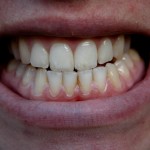
Dental fluorosis is characterised by bilateral, diffuse, thin and horizontal white striations and stained plaque areas, with pitting and discolouration of the enamel in more severe case. It is caused by excess fluoride ingestion during tooth development and can have an impact on quality of life. The aim of this study was to evaluate the acceptability, efficacy and safety of enamel microabrasion and the association of this technique with at-home tooth bleaching on the removal fluorosis stains.
Patients aged 15–39 years old with at least 4 anterior teeth with dental fluorosis ranging from 1 to 7 according to the Thylstrup and Fejerskov (TF) index were randomized into two treatment groups (n = 35): GI – enamel microabrasion or GII – microabrasion associated with at-home bleaching. Microabrasion was performed under rubber dam using 37% phosphoric acid and pumice and, at-home tooth bleaching was carried out using custom trays and 10% carbamide peroxide. Areas of enamel opacities were recorded by digital camera at baseline and 1-month (1 M) after treatment. Two blinded examiners evaluated the reduction in the area (mm2) of opacity using software. Two visual analogue scales were used: one for recording tooth sensitivity and/or gingival irritation ranging from 1 (none) to 5 (severe) and the other to evaluate participant satisfaction with the treatment used ranging from 1 (no improvement) to 7 (exceptional improvement).
- All patients were reviewed at 1-month
- Both groups showed a significant reduction in stained areas (p = 0.0001), but there was no significant difference between the groups.
- Patients from GII reported that they were happier with their dental appearance than patients from group I ( p = 0.004).
- 19 (54.3%) patients who received microabrasive treatment and 30 (85.7%) who received microabrasion and home bleaching reported an improvement in appearance of their teeth from moderate to excellent
- Clinicians assessed 24 (68.6%) patients from GI and 26 (74.3%) from GII as having moderate to excellent improvement in the appearance.
- Most of our patients reported no or mild tooth sensitivity and/or gingival irritation with no difference between the treatment groups.
The authors concluded
Both treatment protocols were effective in reducing enamel fluorosis staining (TF 1–7) and improving the appearance of the teeth. However, patients who used home bleaching after microabrasive treatment were happier with dental aesthetics.
Comment
This small but interesting studies found an improvement in appearance using both microabrasion protocols. While the clinicians assessment of the outcomes indicated little difference between the two protocols those patients who had a more active role in the treatment had a greater pervieved benefit.
Links
Castro KS, de Araújo Ferreira AC, Duarte RM, Sampaio FC, Meireles SS. Acceptability, efficacy and safety of two treatment protocols for dental fluorosis: A randomized clinical trial. J Dent. 2014 Jan 30. pii: S0300-5712(14)00027-X. doi: 10.1016/j.jdent.2014.01.011. [Epub ahead of print] Review. PubMed PMID: 24486675.
